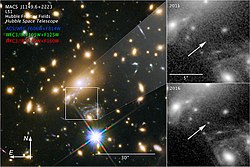Risk assessment
The 9 January 2018 solution with a 15-day observation arc was listed at Torino scale 1 with a 1:21,000 chance of impacting Earth on 30 June 2047. By 9 January 2018, the geocentric 30 June 2047 uncertainty region had shrunk to ±50 million km. With a longer 20 day observation arc, it dropped to Torino scale 0 and had a 1:670,000 chance of impacting Earth on 30 June 2047. [3] On 18 January 2018 it was removed from the Sentry Risk Table. With a 28-day observation arc, the nominal solution suggests it will be about 0.25 AU (37,000,000 km) from Earth on 30 June 2047. The 3-sigma uncertainty in the 2047 close approach distance is about ±13 million km.
This page is based on this
Wikipedia article Text is available under the
CC BY-SA 4.0 license; additional terms may apply.
Images, videos and audio are available under their respective licenses.

